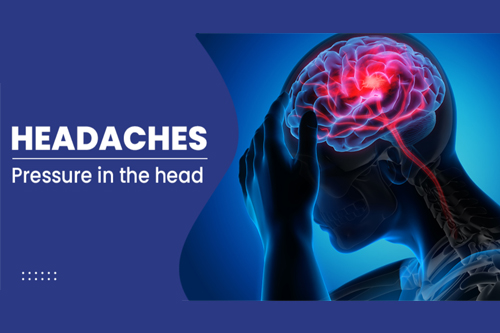
Headache disorders
Headache disorders are among the most common neurological conditions, affecting millions of people worldwide. Although headaches are often dismissed as minor ailments, chronic and recurrent headaches can significantly impact an individual’s quality of life. Furthermore, understanding the different types of headache disorders, their causes, and available treatment options is crucial for effective management. Fortunately, advancements in neurology and pain management have led to better diagnostic techniques and innovative treatment solutions for those suffering from persistent headaches.
Understanding the Types of Headache Disorders
Headache disorders are broadly classified into primary and secondary headaches. While primary headaches occur independently and are not caused by underlying medical conditions, secondary headaches result from another illness or external factor.
1. Primary Headaches
Migraine headaches are often characterized by intense, throbbing pain, usually affecting one side of the head. In addition to severe pain, migraines are frequently accompanied by nausea, vomiting, and sensitivity to light and sound. Moreover, migraines can last for hours or even days, significantly disrupting daily activities. Additionally, certain triggers such as stress, hormonal changes, or specific foods can initiate migraine attacks.
b) Tension Headaches
Tension headaches are the most common form of headache, usually reported as a dull, throbbing pain on both sides of the head. Unlike migraines, tension headaches do not usually bring about nausea or light sensitivity. Furthermore, stress, poor posture, and inadequate sleep are typical triggers for tension headache
c) Cluster Headaches
Cluster headaches are very painful and follow cyclical or cluster patterns. They also tend to cause severe, burning pain near one eye and are followed by symptoms of redness, swelling, and nasal congestion. Although relatively rare, cluster headaches can be highly debilitating and must be treated specially.
2. Secondary Headaches
- Sinus Infections: Sinus headaches occur due inflammation in sinus cavities, often accompanied by facial pressure and nasal congestion.
- Medication Overuse Headaches: Prolonged use of painkillers can lead to rebound headaches, making proper medication management essential.
- Head Injuries: Concussions and traumatic brain injuries can result in persistent headaches requiring medical evaluation.
- High Blood Pressure: Severe hypertension can cause headaches, often accompanied by dizziness and blurred vision.
- Neurological Disorders: Conditions such as brain tumors or meningitis can manifest as secondary headaches, necessitating urgent medical attention.
Diagnosis of Headache Disorders
Accurate diagnosis is crucial for effective headache management. Fortunately, medical professionals employ several diagnostic techniques to determine the cause and type of headache.
Effective Treatment Options for Headache Disorders
With advancements in medical research, various treatment strategies have been developed to manage and prevent headaches effectively. The choice of treatment largely depends on the type and severity of the headache disorder.
1. Medications for Headache Relief
- Several medications are available to alleviate headache symptoms and prevent recurrent episodes. These include:
- Pain Relievers: Over-the-counter (OTC) medications such as ibuprofen and acetaminophen are commonly used for mild headaches.
- Triptans: Specifically designed for migraines, triptans help reduce pain by constricting blood vessels and blocking pain pathways.
- Preventive Medications: For chronic migraine sufferers, beta-blockers, antidepressants, and anti-seizure medications may be prescribed to reduce attack frequency.
2. Lifestyle Modifications and Preventive Measures
- Managing Stress: Practicing relaxation techniques such as meditation, deep breathing, and yoga can help prevent stress-related headaches.
- Maintaining a Consistent Sleep Schedule: Ensuring adequate sleep and establishing a regular sleep routine can minimize headache triggers.
- Staying Hydrated: Dehydration is a common cause of headaches, making proper hydration essential for prevention.
- Avoiding Triggers: Identifying and avoiding foods, drinks, or environmental factors that trigger headaches can be beneficial.
3. Alternative and Complementary Therapies
- Acupuncture: This ancient practice involves inserting thin needles into specific points on the body to relieve pain and reduce headache frequency.
- Chiropractic Care: Spinal adjustments and posture correction can help alleviate tension headaches and migraines.
- Herbal Remedies and Supplements: Certain supplements like magnesium, riboflavin (vitamin B2), and coenzyme Q10 have shown promise in reducing migraine frequency.
Challenges and Future Advancements in Headache Management
- Delayed Diagnosis: Many people ignore recurring headaches, leading to delayed diagnosis and treatment.
- Medication Overuse: Excessive reliance on painkillers can worsen headaches, highlighting the need for proper medical guidance.
- Limited Access to Specialized Care: In some regions, access to neurologists and headache specialists is limited.
On a positive note, ongoing research is paving the way for innovative headache treatments, such as:
- CGRP Inhibitors: These new medications specifically target migraine pathways, offering relief with fewer side effects.
- Wearable Neurostimulation Devices: Non-invasive devices that stimulate nerves to reduce headache intensity are gaining popularity.
- AI-Based Headache Prediction Tools: Machine learning algorithms are being developed to predict headache patterns and suggest preventive measures..Contact Us
Conclusion
In summary, headache disorders are a widespread neurological issue that can significantly impact daily life. However, with accurate diagnosis, effective treatment, and lifestyle modifications, many individuals can successfully manage their headaches. Moreover, ongoing advancements in neurology continue to improve headache treatment options, offering hope to millions of sufferers worldwide. Therefore, staying informed about headache triggers, treatment innovations, and preventive measures is essential for better headache management and overall well-being.Schedule your Consultation with Dr. Ritesh Nawkhare
